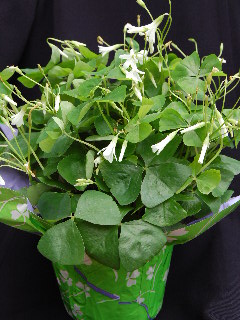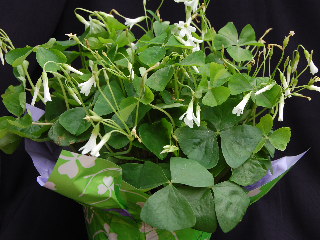
The shamrock plant (Oxalis) is a flowering houseplant commonly associated with Ireland and St. Patrick’s Day.
The three-lobed leaves resemble the three leaves of the clover plant, and legend has it that St. Patrick used the shamrock to illustrate the religious principle of the holy trinity.
This plant seems to have gained favor as a living decoration around the time of the St. Patrick’s Day celebration. It has been known to magically appear in garden centers and retail stores in early March (just in time for the March 17 holiday) much as the poinsettias and Christmas cacti appear in early December!
Here’s the funny part—the shamrock plant isn’t even native to Ireland! Rather, the tender-leaved greenery originated in South America.
As the species came to be associated more and more with the March holiday, its cultivation and marketing spread to other parts of the globe.
Shamrock plant is relatively easy to maintain and makes an unusual and attractive addition to your collection of houseplants.
The plant prefers a moderately moist (not soaking) soil. The surface of the soil should be allowed to just dry out before the next light watering is given.
Also, the plant prefers a cool location (60 to 65 degrees F), and does best with bright indirect light rather than direct sun.
The shamrock plant grows from a bulbous-looking root called a rhizome. The plant will generally do well from early spring through late summer, producing lush green foliage and many small (about 1 inch long) delicate-looking white blooms that resemble miniature trumpet lilies.

Move your plant outdoors to a semi-shaded location on the patio or deck for the warm summer months. As the summer fades, so will your shamrock plant.
As the leaves start to wither and brown in the early fall, allow the plant to dry out.
It can safely spend the winter in a dormant state in your garage or basement.
Then, in late January or early February, cut off the brown tops of your shamrock plant (if you haven’t already done this), and begin watering it again to bring the plant back to life in anticipation of another March 17 St. Patrick’s Day celebration.
A light dosage of good organic plant food will send your festive greenery into celebratory mode, and another light feeding or two during the spring and summer will help maintain its vigor.
Get yourself a shamrock plant and enjoy “growin’ of the green” to produce an unusual houseplant that will help you with your celebration when it’s time for the “wearin’ of the green.” Happy St. Patrick’s Day!
 The shamrock plant (Oxalis) is a flowering houseplant commonly associated with Ireland and St. Patrick’s Day.
The shamrock plant (Oxalis) is a flowering houseplant commonly associated with Ireland and St. Patrick’s Day.
 Move your plant outdoors to a semi-shaded location on the patio or deck for the warm summer months. As the summer fades, so will your shamrock plant.
Move your plant outdoors to a semi-shaded location on the patio or deck for the warm summer months. As the summer fades, so will your shamrock plant.